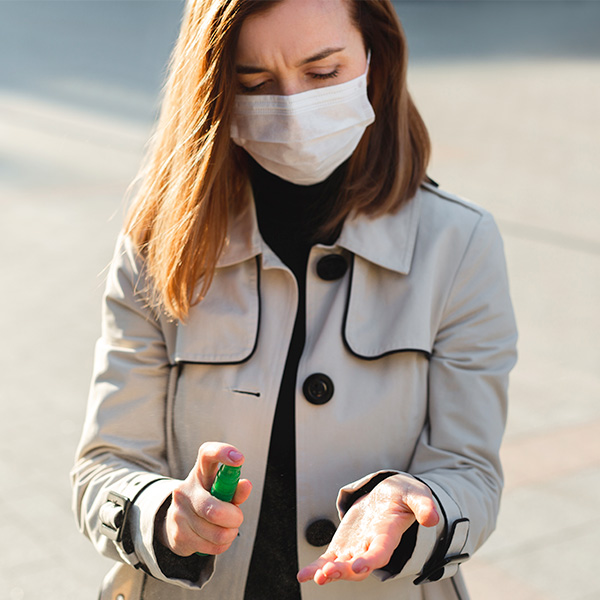“Influenza” or “real flu” is the term used to describe an illness caused by the influenza virus. Seasonal influenza is a preventable infectious disease, mainly involving respiratory symptoms. The influenza virus which is moderately infectious, is predominantly spread via droplets and contacts, or indirectly via respiratory secretions on hands, tissues, etc. Aerosol transmission can also play a part in spread of the virus.
Transmission

People usually become infected when an ill person sneezes and the droplets are inhaled. Influenza viruses can also survive outside the body for up to several hours – if the hands come into contact with objects on which virus-containing secretions are found (e.g. door handles) and then touch the nose or other mucous membranes, infection is also possible.
As part of the intensified hygienic measures due to the new corona virus, the wearing of masks and increased hand washing led to a significant reduction in infections that are typically transmitted by droplet and smear infection, including influenza. With these few mild flu seasons, though, the immunity in the population is probably lower than what it is entering an average flu season: This is probably one reason why currently Australia and New Zealand (southern hemisphere) is facing its worst flu season in five years. Cases peaked about three times higher than the average for that period, and they topped out about two months earlier than they normally do – knowing full well that currently the peak of those affected are children and young adults.
Now that wearing masks is voluntary and people are no longer avoid crowded spaces, there is a potential for more transmission of influenza also in the northern hemisphere, which could become another challenge for society and health infrastructure, in particular in the context of a possible worsening corona situation in autumn and winter.
Symptoms
Uncomplicated seasonal influenza disease presents as rapid onset of the following combination of systemic and respiratory symptoms:
- fever or feverishness;
- headache;
- muscle pain;
- general feeling of ill-health;
- runny nose;
- sore throat;
- dry cough.
Not all of those infected present all symptoms. During a typical influenza season it has been estimated that approximately 75% of the seasonal influenza infections are asymptomatic = not showing any symptoms at all.
In uncomplicated adult cases, systemic symptoms usually last a few days while sore throat and runny nose may last longer. Coughing, fatigue, and malaise may continue for some weeks.
Seasonal influenza is a disease that annually affects Europe and the rest of the northern hemisphere during the winter season with larger or smaller epidemics, infecting approximately up to thirty per cent of the population, and causing hundreds of thousands of hospitalisations. For Europe, each year, seasonal influenza is responsible for up to 50 million symptomatic cases, and 15 000–70 000 European citizens die of causes associated with influenza. Despite the usually short duration of illness, the annual economic and healthcare burden of influenza is substantial.
We distinguish between the « real flu » and the flu-like infection, which is usually not an infection with the influenza virus, but a cold. Gastrointestinal flu also has nothing to do with influenza. This term is used for gastrointestinal infections caused by different pathogens that lead to diarrhoea and vomiting, for example.
Prevention/Treatment
The immune system and thus the defense against pathogens can be brought into high performance through regular sporting activities and a well-balanced healthy diet. This is what science teaches us! Observing simple hygiene measures can further help to reduce the risk of infection – this has become part of everyone’s awareness in recent years when dealing with coronavirus.
Most simple seasonal influenza cases are managed symptomatically and are advised to stay at home and rest to minimize the risk of infecting others in the community. Treatment focuses on reducing fever and relieving the symptoms. The diagnosis can be confirmed by taking specimens for laboratory analysis. It is considered important that patients monitor themselves to detect whether their condition deteriorates, and they require medical intervention.

Vaccination
Type A and B viruses, the predominant virus types causing disease in humans. The genome of influenza viruses is subject to a significant spontaneous mutation rate, known as antigenic drift. This results in gradual changes of the human seasonal influenza viruses and leads to an annual update of the influenza vaccines.
How effective the seasonal influenza vaccine is each season depends on the match between the selected vaccine viruses and those found circulating, and will therefore vary from year to year. In order to find the best match and increase the vaccine effectiveness, experts meet each February/March to review the precise influenza strains to include in the forthcoming season’s vaccine to be used in the northern hemisphere. This process is managed by the World Health Organization (WHO).
Health officials in Luxembourg recommend that people above the age of 65 and those with pre-existing conditions get vaccinated in the upcoming flu season:
- Chronic diseases of the respiratory organs;
- Heart or Circulatory diseases;
- Liver or Kidney disease;
- Diabetes or other Metabolic diseases;
- Chronic underlying neurological diseases such as multiple sclerosis with episodes triggered by infections;
- Congenital or acquired immunodeficiency or HIV;
- Persons at increased risk (e.g. medical staff, nursing staff);
- Persons who may act as a possible source of infection for at-risk persons in their care;
- Residents of old people’s or nursing homes.
While immunising members of risk groups means direct protection, there is also an indirect protection strategy of immunising those with close contact with people in the risk groups.



